Soil Health Management Enhances Microbial Nitrogen Cycling Capacity and Activity
- PMID: 33441406
- PMCID: PMC7845608
- DOI: 10.1128/mSphere.01237-20
Soil Health Management Enhances Microbial Nitrogen Cycling Capacity and Activity
Abstract
Soil microbial transformations of nitrogen (N) can be affected by soil health management practices. Here, we report in situ seasonal dynamics of the population size (gene copy abundances) and functional activity (transcript copy abundances) of five bacterial genes involved in soil N cycling (ammonia-oxidizing bacteria [AOB] amoA, nifH, nirK, nirS, and nosZ) in a long-term continuous cotton production system under different management practices (cover crops, tillage, and inorganic N fertilization). Hairy vetch (Vicia villosa Roth), a leguminous cover crop, most effectively promoted the expression of N cycle genes, which persisted after cover crop termination throughout the growing season. Moreover, we observed similarly high or even higher N cycle gene transcript abundances under vetch with no fertilizer as no cover crop with N fertilization throughout the cover crop peak and cotton growing seasons (April, May, and October). Further, both the gene and transcript abundances of amoA and nosZ were positively correlated to soil nitrous oxide (N2O) emissions. We also found that the abundances of amoA genes and transcripts both positively correlated to field and incubated net nitrification rates. Together, our results revealed relationships between microbial functional capacity and activity and in situ soil N transformations under different agricultural seasons and soil management practices.IMPORTANCE Conservation agriculture practices that promote soil health have distinct and lasting effects on microbial populations involved with soil nitrogen (N) cycling. In particular, using a leguminous winter cover crop (hairy vetch) promoted the expression of key functional genes involved in soil N cycling, equaling or exceeding the effects of inorganic N fertilizer. Hairy vetch also left a legacy on soil nutrient capacity by promoting the continued activity of N cycling microbes after cover crop termination and into the main growing season. By examining both genes and transcripts involved in soil N cycling, we showed different responses of functional capacity (i.e., gene abundances) and functional activity (i.e., transcript abundances) to agricultural seasons and management practices, adding to our understanding of the effects of soil health management practices on microbial ecology.
Keywords: agroecosystems; conservation agriculture; denitrification; nitrification; nitrogen fixation; quantitative PCR (qPCR); quantitative reverse transcription PCR (qRT-PCR); soil health; soil microbes; soil microbiology; soil nitrogen cycle.
Copyright © 2021 Hu et al.
Figures
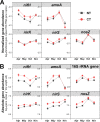
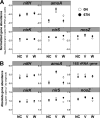
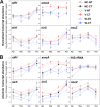
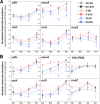
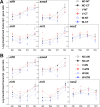


Similar articles
-
Linking changes in snow cover with microbial nitrogen cycling functional gene abundance and expression in agricultural soil.FEMS Microbiol Ecol. 2019 Jul 1;95(7):fiz073. doi: 10.1093/femsec/fiz073. FEMS Microbiol Ecol. 2019. PMID: 31167230
-
Microbial N-cycling gene abundance is affected by cover crop specie and development stage in an integrated cropping system.Arch Microbiol. 2020 Sep;202(7):2005-2012. doi: 10.1007/s00203-020-01910-2. Epub 2020 May 20. Arch Microbiol. 2020. PMID: 32436040
-
The effect of biochar amendment on N-cycling genes in soils: A meta-analysis.Sci Total Environ. 2019 Dec 15;696:133984. doi: 10.1016/j.scitotenv.2019.133984. Epub 2019 Aug 19. Sci Total Environ. 2019. PMID: 31465924
-
The Importance of the Microbial N Cycle in Soil for Crop Plant Nutrition.Adv Appl Microbiol. 2015;93:45-71. doi: 10.1016/bs.aambs.2015.09.001. Adv Appl Microbiol. 2015. PMID: 26505688 Review.
-
Soil nitrogen cycling gene abundances in response to organic amendments: A meta-analysis.Sci Total Environ. 2024 Apr 15;921:171048. doi: 10.1016/j.scitotenv.2024.171048. Epub 2024 Feb 20. Sci Total Environ. 2024. PMID: 38387590 Review.
Cited by
-
Variation in Bacterial Community Structure Under Long-Term Fertilization, Tillage, and Cover Cropping in Continuous Cotton Production.Front Microbiol. 2022 Apr 4;13:847005. doi: 10.3389/fmicb.2022.847005. eCollection 2022. Front Microbiol. 2022. PMID: 35444635 Free PMC article.
-
Green manure application improves insect resistance of subsequent crops through the optimization of soil nutrients and rhizosphere microbiota.iScience. 2024 Jun 20;27(7):110320. doi: 10.1016/j.isci.2024.110320. eCollection 2024 Jul 19. iScience. 2024. PMID: 39055949 Free PMC article.
-
Nitrogen Fertilization and Native C4 Grass Species Alter Abundance, Activity, and Diversity of Soil Diazotrophic Communities.Front Microbiol. 2021 Jul 8;12:675693. doi: 10.3389/fmicb.2021.675693. eCollection 2021. Front Microbiol. 2021. PMID: 34305840 Free PMC article.
-
The impact of different preceding crops on soil nitrogen structure and nitrogen cycling in tobacco-planting soil.Sci Rep. 2024 Jan 20;14(1):1767. doi: 10.1038/s41598-024-52285-z. Sci Rep. 2024. PMID: 38243087 Free PMC article.
-
Role of Agricultural Management in the Provision of Ecosystem Services in Warm Climate Vineyards: Functional Prediction of Genes Involved in Nutrient Cycling and Carbon Sequestration.Plants (Basel). 2023 Jan 23;12(3):527. doi: 10.3390/plants12030527. Plants (Basel). 2023. PMID: 36771611 Free PMC article.
References
-
- White PJ, Crawford JW, Díaz Álvarez MC, García Moreno R. 2012. Soil management for sustainable agriculture. Appl Environ Soil Sci 2012:850739. doi:10.1155/2012/850739. - DOI
-
- Chapin FS, Matson PA, Mooney HA. 2002. Principles of terrestrial ecosystem ecology. Springer, New York, NY.
Publication types
MeSH terms
Substances
LinkOut - more resources
Full Text Sources
Other Literature Sources
Miscellaneous
